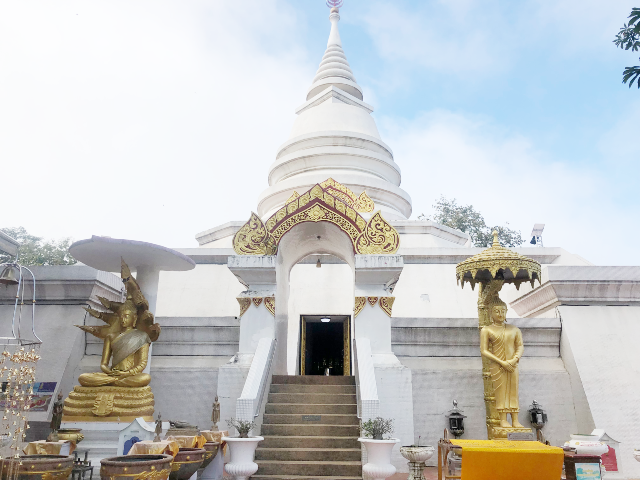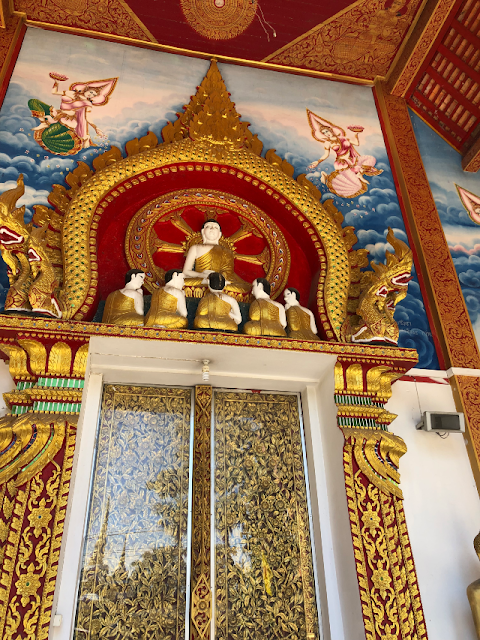Visit to this wat, known as Sri Kerd, Sri Gird, Srikird was an unplanned one, I did not see its name on places to see in Chiang Rai. We were going to King Mengrai's Memorial, took a wrong turn and saw this wat on my right side. I came back to the hotel and searched for it. I did not get much details much about it, only that it was an old wat.
We decided to visit that place. To my disappointment, the viharn was closed that day so we decided to come back the following day. Again the viharn was closed. Since, we were leaving the next day, my husband went to talk to a monk and explained our situation. He said, he will come and open the viharn door for us.
The wat had few surprises for me. I will uncover all surprises:)
History of this wat:
- The history of this temple is not very clear but possibly it was constructed in 1440.
- The temple is named after the tree Sri Maha Bodhi, under which Gautam Buddha attained nirvana. The Thai alphbets does not have r-sound, so it became "sa-lee".
- Depending on the prefix in conjuction with the word, Sri is equivalent to "Mr." in India, it is used with the name of god, kings, spiritual leaders etc. It is also another name for Lakshmi, goddess of wealth. Here, in the present context it means sacred, an honor which is given to a wat or a place.
- The temple is located within the city wall, a little further away from the heart of city.
- It is situated in eaternmost part of city so it used to get the first rays of sun.
What to see here:
- coiled naga at entrance
- entrance door to viharn
- bronze image at altar
- pulpit which is black and gold and is in a corner
- ancient Lanna chest
main entrance guarded by golden lions
coiled naga at entrance
Viharn:
The beautiful viharn is designed in Lanna style and is guarded by coiled nagas on either side of its entrance.
The coiled naga balustrade were so pretty, I could not stop myself from taking pictures.
Most of the wats I had seen had naga balustrade, but here and also at Wat Chetupon, I was fascinated by the coiled naga balustrade. The naga coil and the tail extends upto the pillar of viharn.
Till the time, my husband comes back, I thought of admiring the entrance.
Buddha with dharam chakra behind giving his first sermon to five of his disciples is portrayed on top of the door.
This is the side door with dharam chakra encircled by naga on top.
gong on the side
red and gold pillar on side of entrance
beautiful carved wood work on door depicting forest in Himvanta, a legendary forest in the hills of Himalayas.
Buddha in different poses on the side of viharn
main altar
The
principle Buddha image, big one in the above picture is the stucco image in local Lanna style in Chiang Sean Singh1 style where the body is plump, head has a topknot and has the shape of semi-opened lotus flower. Hair is in curls.
There is another image made of bronze, looks black in the picture. This is Phra Buddha Sri Ming Mongkol. The posture is in bhumisparsh or calling earth to witness. It is in Chiang Saen Singh 2 style. Here, the body is less plump, chest is not covered. Head and topknot rounder like closed lotus. It is situated in front of the principle Buddha image.
On looking carefully, you can see pulpit on our right side. This was the first time, I had seen pulpit in a wat.
Ancient Lanna pulpit:
The ancient Lanna pulpit is made of wood and gilded over with lacquer.
The head monk sits on the pulpit to teach Dharma
Ancient Lanna chest:
The trapezoid chest is made of wood gilded over with lacquer. It is used to store Buddhist scriptures.
Seeing the chest had escaped my eyes, so when I came out, I asked the monk about where the chest was. The monk took us inside and showed us the cabinet.
ancient Lanna chest
another view of chest
what a treasure inside!
The monk opened the chest and showed us the scriptures which were handwritten and in Pali.
I forgot to ask his name, sometimes when you are so excited looking at the treasure that you remember all these things as an after thought. My mother always used to say that I forget to ask the important things at the right time :(
Thank you phra, for showing us around.
He even read out few verses from the scripture and took pride in doing that.
ancient Lanna Dhamma book
cupboard to store Tripitaka
The three-tiered roof viharn was granted Wisung Khama Sima in 1970. This means a royal granting of land for monks to have an ubosoth or ordination hall to do religious rites.
Decorated windows with chinese zodiac signs.
The window too are made of carved wood with design of entwined sprays in Himvanta (Buddhist legendary forest). Notice, the window has a tiger on top.
entrance as viewed from inside
Chedi or stupa:
The Lanna style chedi rests on a square base with umbrella on four sides.
Two thewada figures stand in front in yai posture. Two monks, Khruba Siwichai sit in front at the base. Buddha image stands in an alcove.
On the top is a 5-tiered umbrella in receding order, which sits on a bell shaped base.
The chedi has golden umbrella on its four corners.
green and golden mom beside the chedi
bell tower
information board near the chedi
I saw this beautiful peacock on the side and wondered why a peacock and in Thailand? I still have not been able to understand the reason but one thing I was able to figure out after reading was that Buddhists believe in a peacock as a sign of long life or immortality. Peacocks generally eat stuff which is harmful to humans. Because of this thinking, Buddhists thought that peacocks could endure sufferings and live longer.
Dharma Chakra on the roof of other gate
Dharma Chakra

gnarring lions to protect the wat
Entrance fee: free
Timings: 0800 to 1700 hours, daily




























































